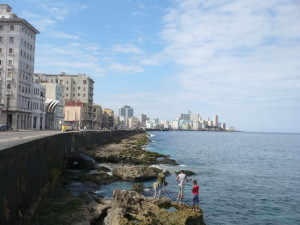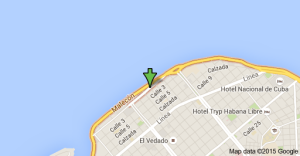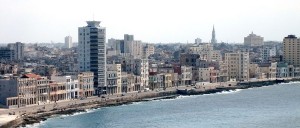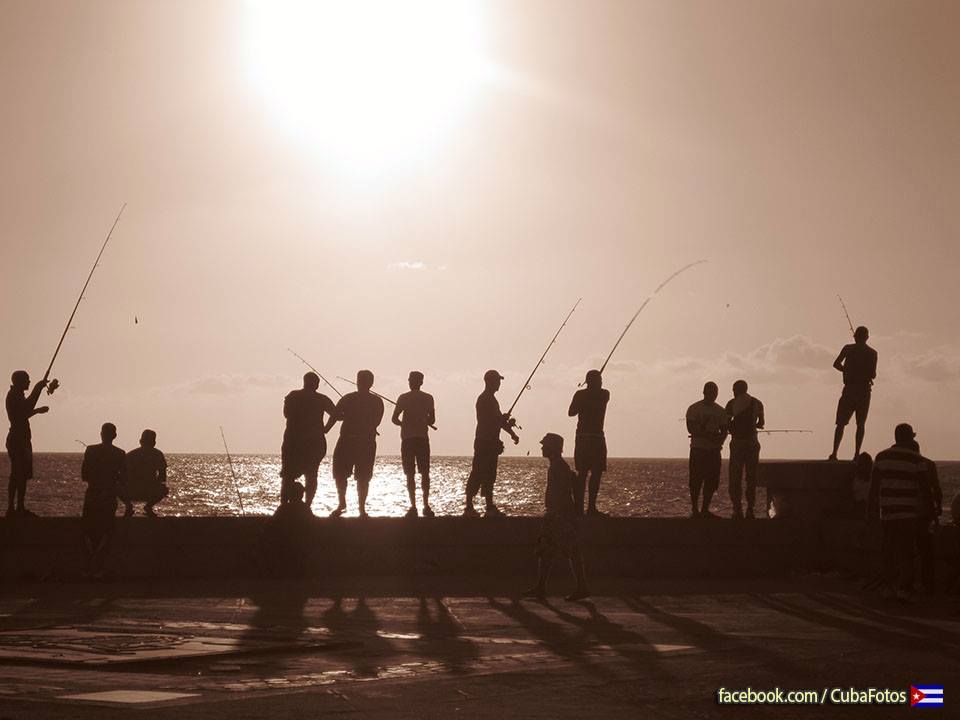THE CITY OF HAVANA AND ITS ESSENTIAL “MALECÓN”.
One of the most enjoyable place for the residents of Havana is “El Malecón”, a wall one meter high surrounding much of the Havana coastline.
Under the American interventionist government in 1901 it built the first section, which extended from the Castillo de la Punta to the street Crespo, that is, about 500 meters long, with lush trees and luminaries.
The main purpose of its construction was to defend the capital against the waters and called ¨ ¨ Norths, but actually served more to night walks of Havana, for lovers and especially for individual fishermen.
Havana Malecon history is really interesting.
To celebrate the opening of the first 500 meters of boardwalk, the US government built a beautiful gazebo on the corner of Paseo del Prado, as the architects of the time, was the first work of reinforced concrete, with cabillas- in our country. In front of the gazebo, where every Sunday a band playing Cuban melodies, the Miramar hotel, very fashionable rose for the first fifteen years of the republic for the first time and where the waiters wore tuxedo, golden-breasted vest without mustaches .
The Cuban government continued following the extension of the first section of the Malecón. It was in 1923 that could reach the mouth of the Almendares River, the height of the K streets and L Vedado, where the US Embassy, the famous Deportivo José Martí Park was built and beyond Hotel Rosita de Hornedo, today called Sierra Maestra.
Currently, the Malecón habanero remains the busiest place of Cubans, especially the Cubans who lack the financial means to attend a nightclub for which payment is in foreign currency, or a hotel, all exclusive to foreigners.
Furthermore, it is well known that the Malecon is a source of income for very poor families, who performed during the evening hours fishing for their livelihoods.
Really depressing spectacles can also be seen on the Malecon, when police almost permanently monitors women and young men who go hunting for tourists to exercise the oldest profession humanity.
Despite being almost in ruins and valuable old buildings that are parallel to the Malecon, after being arrested on architectural development since the triumph of the Castro regime is still very beautiful coastline of the capital. Cubans and those who visit us, no longer visit and admire one of the most beautiful places in Havana.
Agencies / Tania Diaz Castro / InternetPhotos / wwww.thecubanhistory.com
The Cuban History, Hollywood.
Arnoldo Varona, Editor.
LA CIUDAD DE LA HABANA Y SU IMPRESCINDIBLE “MALECÓN”.
El lugar de mayor expansión para los habitantes de la capital cubana es El Malecón, un muro de un metro de alto que rodea gran parte del litoral habanero.
Bajo el gobierno interventor norteamericano se construyó en 1901 el primer tramo, que comprendía desde el Castillo de la Punta hasta la calle Crespo, o sea, unos 500 metros de largo, con una exuberante arboleda y numerosas luminarias.
El objetivo principal de su construcción fue para la defensa de la capital contra las aguas y los llamados ¨ Nortes ¨, pero en realidad, sirvió mucho más para paseos nocturnos de los habaneros, para los enamorados y sobre todo para pescadores particulares.
La historia del Malecón habanero es realmente interesante.
Para celebrar la inauguración de los primeros 500 metros de malecón, el gobierno de Estados Unidos construyó una bonita glorieta en la esquina del Paseo del Prado que, según los arquitectos de la época, fue la primera obra realizada de hormigón armado –con cabillas- en nuestro país. Frente a la glorieta, donde cada domingo una banda de música tocaba melodías cubanas, se levantó el hotel Miramar, muy de moda durante los primeros quince años de república y donde por primera vez los camareros vistieron de smoking, chaleco con abotonadura dorada y sin bigotes.
Los siguientes gobiernos cubanos continuaron la extensión del primer tramo del Malecón. Fue en 1923 que pudo llegar hasta la desembocadura del río Almendares y a la altura de las calles K y L del Vedado, donde se construyó la Embajada de Estados Unidos, el famoso Parque Deportivo José Martí y más allá el Hotel Rosita de Hornedo, hoy llamado Sierra Maestra.
En la actualidad, el Malecón habanero sigue siendo el lugar más concurrido de los cubanos, sobre todo por los cubanos de a pie que carecen de medios económicos para frecuentar una discoteca cuyo pago es en divisas, o un hotel, todos exclusivos para extranjeros.
Además, es conocido por todos que el Malecón es fuente de ingresos para familias muy pobres, que durante las horas nocturnas realizan la pesca como medio de subsistencia.
Espectáculos realmente deprimentes pueden verse también en el Malecón habanero, cuando la policía casi de forma permanente vigila a las mujeres y hombres jóvenes que andan a la caza de turistas para ejercer el oficio más antiguo de la humanidad.
A pesar de verse casi en ruinas las antiguas y valiosas edificaciones que van de forma paralela al Malecón, tras ser detenido el desarrollo arquitectónico a partir del triunfo del régimen castrista, aún es muy bello el litoral de la capital. Tanto los cubanos como aquellos que nos visitan, no dejan de visitar y admirar uno de los lugares más hermosos de La Habana.
Agencies/Tania Díaz Castro/InternetPhotos/wwww.thecubanhistory.com
The Cuban History, Hollywood.
Arnoldo Varona, Editor.






